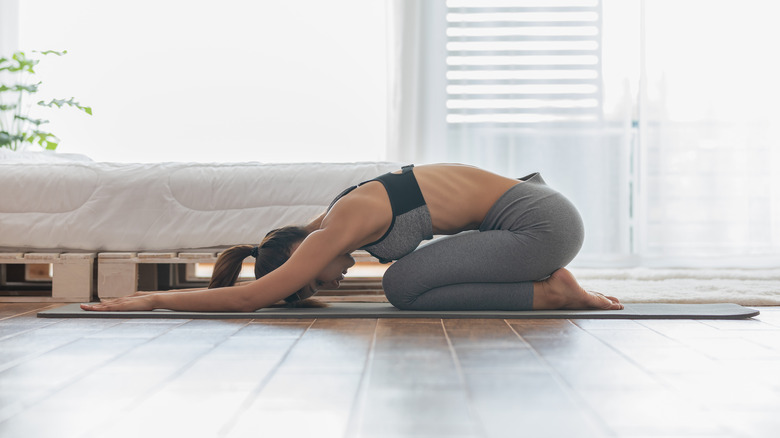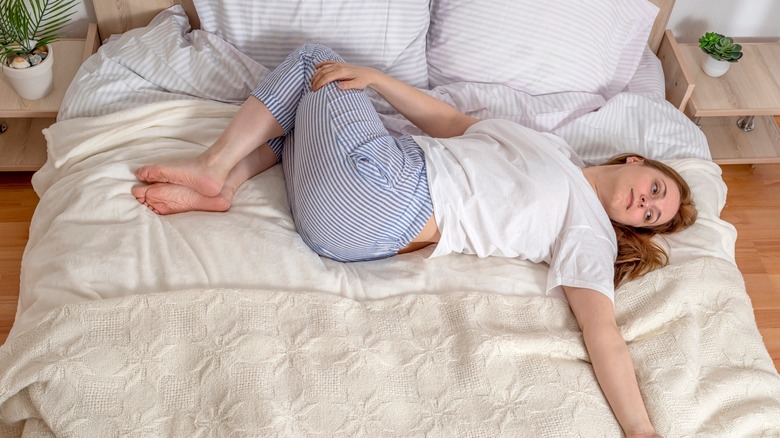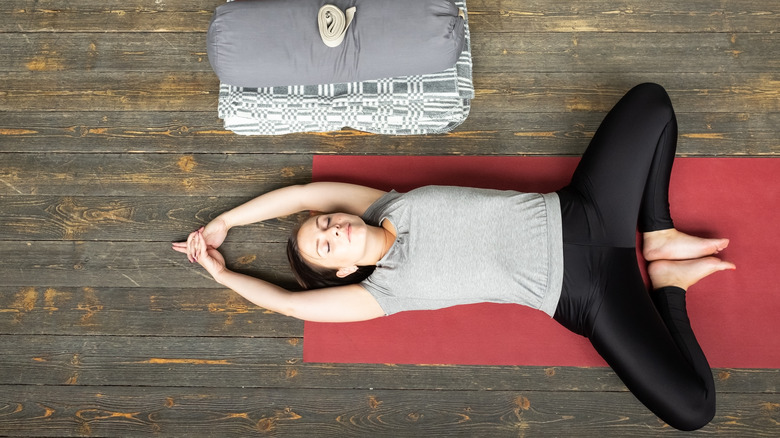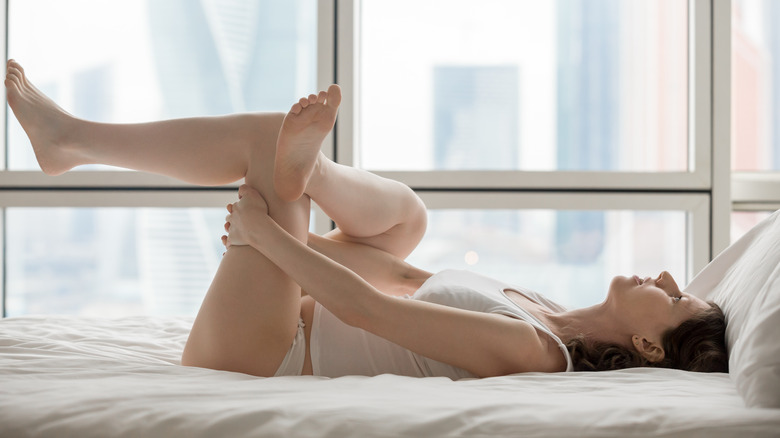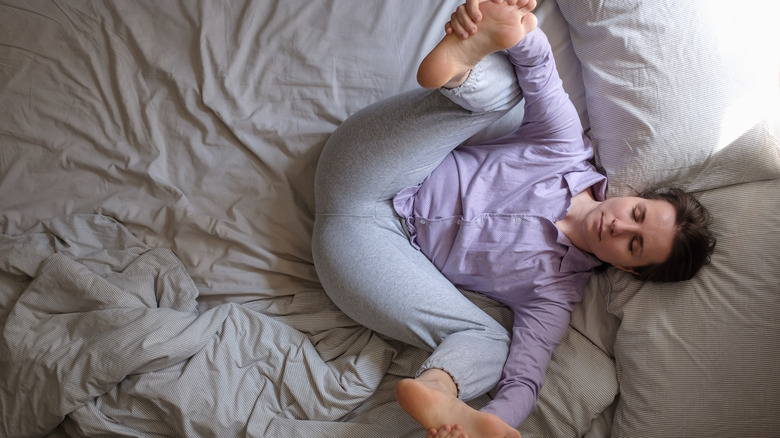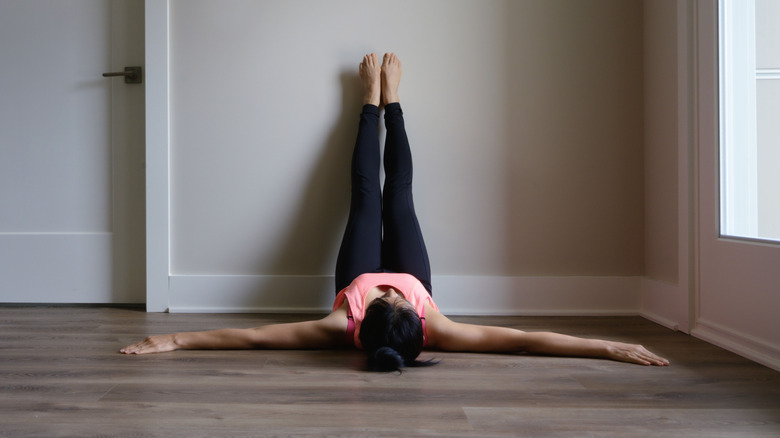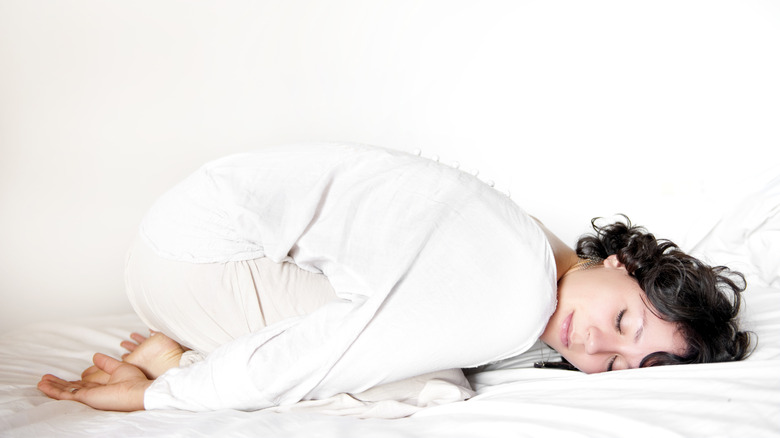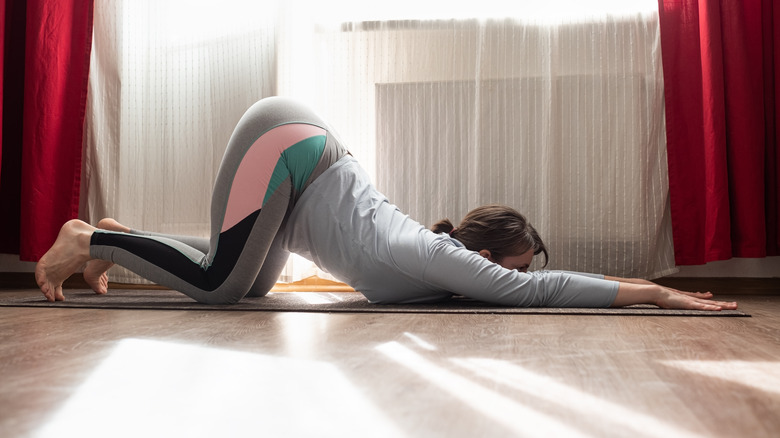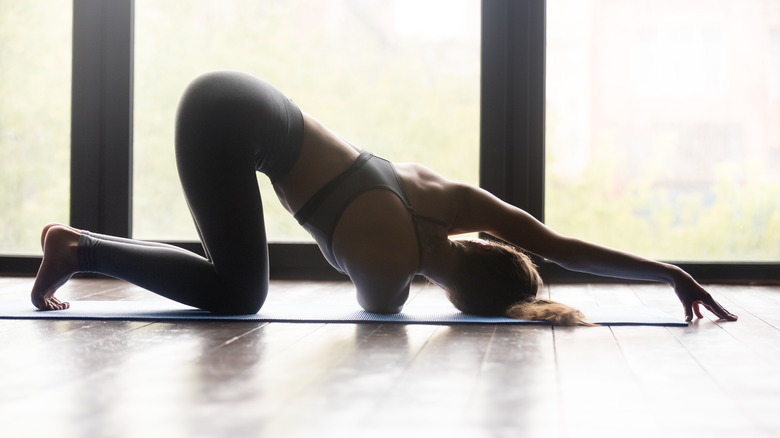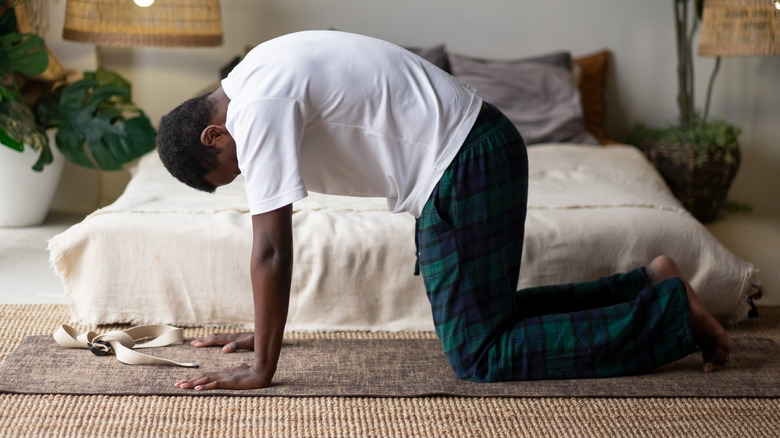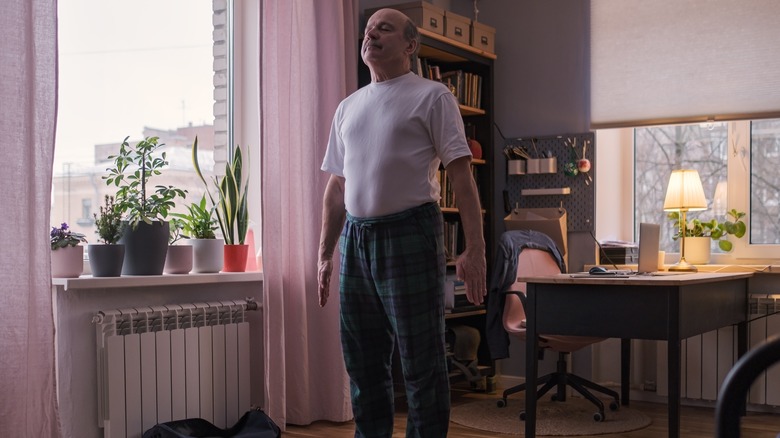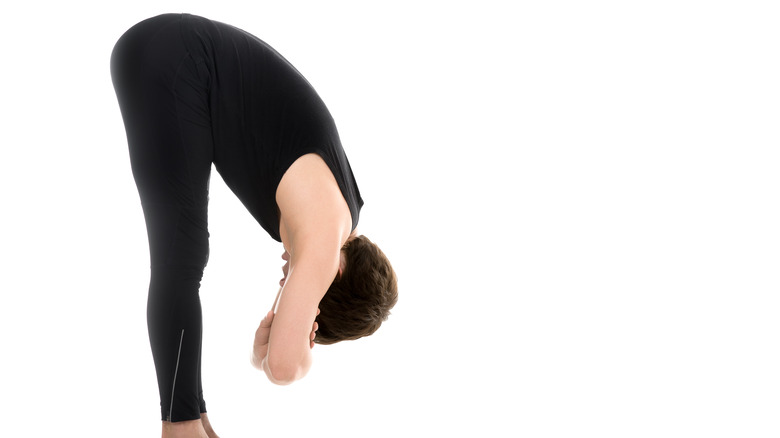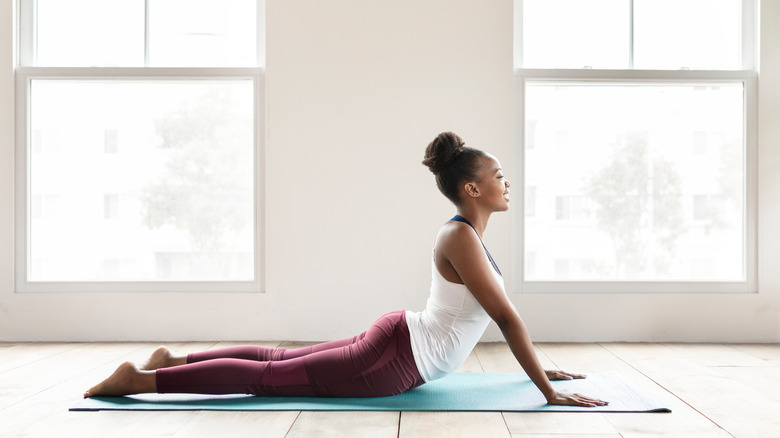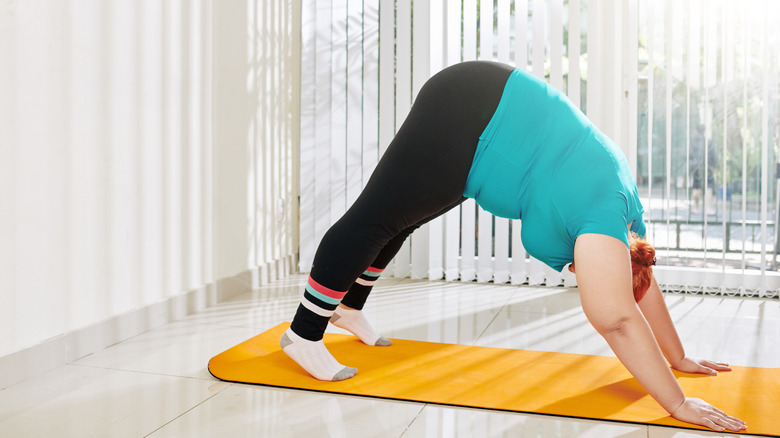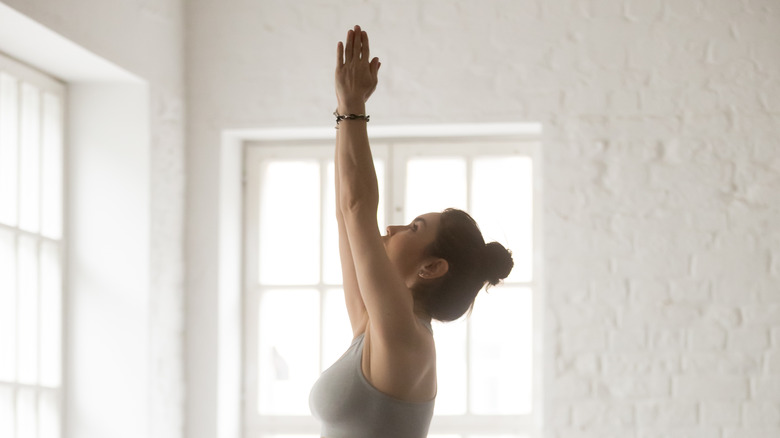14 Yoga Stretches To Help You Wake Up Every Morning
Yoga is a system of spiritual practices that date back to ancient India. According to the National Center for Complementary and Integrative Health (NCCIH), elements of yoga have been adopted by Westerners as a method for improving physical and mental health. Though traditional yoga encompasses several spiritual practices, per yoga expert and activist Susanna Barkataki, most practitioners in the West only focus on asana (the poses), pranayama (breath work), and dhyana (meditation).
As the NCCIH notes, practicing yoga — even the bits and pieces that we practice in the West — can have a significant impact on wellbeing. Practicing yoga can help people manage stress and mental health conditions, quit smoking, manage the symptoms of some chronic illnesses, and relieve pain from myriad conditions. Yoga certainly isn't a panacea, but it can be a powerful part of a healthy lifestyle.
Though yoga is beneficial whenever you choose to practice, many yoga teachers and fitness professionals recommend practicing in the morning, per Yoga Basics. Doing your yoga practice first thing in the morning allows you to set the tone for your day by setting your intentions and engaging in meditation. Morning yoga also shifts your mindset by relieving stress and clearing your mind, so you're ready for anything the day brings. And if you often wake up stiff or sluggish, the gentle morning movement helps to relieve pain and get the blood flowing. Here are some easy poses and flows that can help you start your day right.
Supine Spinal Twist (Supta Matsyendrasana)
One of the best things about practicing yoga first thing in the morning is that you don't even have to get out of bed. You can start out with some supine spinal twists, which are done lying down per Yoga Journal. These spinal movements, also called Supta Matsyendrasana in Sanskrit and reclining twists in English, per Yogapedia, are a gentle, simple way to start moving your body and your energy first thing in the morning. Supine spinal twists also provide a full-body stretch, with specific focus on the back, hips, and chest, making it the perfect pose for those of us who wake up stiff and achy.
To get into this pose, start by lying on your side with both knees stacked on top of each other, just like you would if you were sleeping on your side. Take a deep breath, and as you exhale, slowly twist open through your chest by moving your top arm. When both shoulders are on the bed, extend the arm you just moved out to the side. Your arm will reach in the opposite direction of your knees. If it's comfortable for you, your head can turn to look toward your outstretched arm, extending the twist all the way through your neck. Hold this position while you breathe deeply. Then, roll to the side of the outstretched arm, get in your comfy side-sleeping position on the other side, and move into the stretch again.
Supine butterfly pose (Supta Baddhakonasana)
Another yoga stretch you can do in bed without even sitting up is supine butterfly pose, or Supta Baddhakonasana in Sanskrit, per Fitsri. Lying on your back, bend both knees by bringing your feet toward your buttocks while keeping both feet planted on the bed. On an exhale, let your knees fall to opposite sides, opening up your pelvis. Your feet will rotate so the soles of your feet press together. When your legs are in place, they will create a diamond shape with your feet and your pelvis.
If your hips are relatively flexible, then your knees may reach the bed. If they don't, that's fine. They can hover over the bed, or you can place one pillow under each knee so they can rest on a heightened surface. Hold this pose while you breathe deeply, focusing on letting the hips, back, and legs relax. You'll feel a good stretch in the front and back of your hips as well as a slight stretch through your back. This pose is great for people who wake up with sore hips or a stiff back.
According to Fitsri, supine butterfly pose opens the entire lower body, promoting blood flow and the flow of energy through the mid and lower body. The site suggests practicing Supta Baddhakonasana in the morning to revitalize your body after sleep and carry good energy into the day.
Supine pigeon pose (Supta Kapotasana)
Supta Kapotasana, also known as supine pigeon pose, reclining pigeon pose, or ankle-to-knee pose, is another great hip opener that can be done while you're still lying in bed. According to the Yogi Times, reclining pigeon pose is a gentle, relaxing stretch that targets the hips, the back of the legs, and the low back. This pose is a great choice first thing in the morning because it helps you tune into how your lower body is feeling and release any tension built up from the day or night before. It's also a relaxing stretch that gets your body moving slowly first thing in the morning.
To get into Supta Kapotasana, bend one knee up by bringing one foot toward your buttocks. Keep the foot planted on the ground (or your bed), and on an inhale, bring the ankle of the opposite foot to your bent knee. When your ankle is in place, let the knee on the same side open up, moving away from your torso. If bringing the ankle to the knee provides enough of a stretch for you, settle into the pose and hold it while you breathe deeply. If this you're not feeling much, wrap your hands around the thigh of the leg connected to the bed. Gently pulling that leg toward your chest will deepen the stretch.
Happy baby pose (Ananda Balasana)
Happy baby pose, or Ananda Balasana in Sanskrit, is a great pose to practice in the morning because it opens the hip joints, relieves lower back pain, and it brings joyful energy into your day, according to ePainAssist. The site suggests that happy baby allows us to connect with our inner child, which sounds like a great way to start the day.
If you've ever seen a baby discover their feet for the first time, you can probably picture what this pose looks like. To get into the pose while you're still in bed, lie on your back and raise both feet in the air. Bend your knees out to the sides so you can grab your feet, one hand on each foot. You can grab on the inside or the outside of each foot and hold onto the soles of the feet. If you can't reach your feet, you can put a yoga strap, a towel, or even a rolled-up shirt around each foot and grab the ends.
Pull your feet toward your chest, bending deeply in the knees to open the hips and the inner thighs. You can hold the stretch here and breathe deeply, or you can slowly rock side to side on the lower back, breathing deeply as you do so, to add a little movement and a gentle massage for the low back.
Legs up the wall pose (Viparita Karani)
Legs up the wall pose, Viparita Karani in Sanskrit, is one of the easiest inversions, or upside-down poses, in yoga, per DoYou. Inversions help regulate the body by improving circulation, increasing energy flow, and relieving pain. However, many inversions are considered advanced poses and often require a lot of effort. While the effort is worth the benefits, sometimes we all want an easier option. Viparita Karani is that easier option, and it's yet another yoga stretch that you can do in bed, first thing in the morning, as long as your bed is against a wall or has a solid headboard.
Start by scooting your buttocks close to the wall or headboard. Don't put your butt right against the surface, but get close. Lie on your back and slowly raise one leg at a time, resting the backs of your legs against the wall. Once your legs are on the wall, flex your feet so your heels rest against the wall. This will engage your glutes and hamstrings, getting them involved in the stretch. As you breathe deeply and relax into the pose, your mind will clear, your body will start to feel more balanced, and you'll feel energized. This makes legs up the wall pose one of the best poses to do as soon as you wake up.
Child's pose (Balasana)
When you're not quite ready to wake up yet, child's pose or Balasana is a great way to stretch your body while still indulging in some morning rest. DoYou notes that child's pose helps us to connect to the importance of rest, which is a crucial lesson to take into our busy daily lives. It also provides a gentle stretch for the hips and the entire back, which we all need when we first wake up.
Some people like to do Balasana with their knees together so their torso rests on the thighs. Others like to keep their feet together and spread their knees out wide so the torso rests between the thighs instead. It's really all about what works for your individual body. If you're keeping your knees together, sit on your shins, then slowly lower your torso on top of your thighs. Release the tension in your back and let your upper body be supported by your lower body. Your arms can reach out in front of you, or rest beside your legs, reaching behind you, with your palms up. If you're opening your knees, come onto all fours, spread your knees apart, and then push your hips toward your feet. Lower your torso between your legs and reach your arms out in front of your body. Sink your chest toward the floor as you push your hips back toward your heels.
Extended puppy pose (Uttana Shishosana)
If you're looking for a bigger morning stretch, particularly through your arms, shoulders, and back, then extended puppy pose is an excellent way to begin your morning. Uttana Shishosana, the pose's Sanskrit name, is a lot like child's pose, but it offers a deeper stretch and a slight inversion, according to Jive Yoga Live. This is an ideal morning stretch because it stretches the entire upper body.
To get into extended puppy pose, start on your hands and knees. Keeping your hips parallel to the ground and right over your knees, walk your hands out in front of you. As your hands get further from your body, sink your chest down toward the ground. Keep walking your hands out in front of you until your arms are reaching straight ahead and your chest and forehead are resting on your bed, or the ground if you've made it out of bed.
You'll end up in a gentle backbend with your hips high and centered over your knees. If your forehead and chest can't rest on the bed ground, don't worry — grab a pillow and place it vertically under your torso and head. Lower down to the pillow instead of the bed or ground. Breathe deeply into the back and the arms as you relax into the pose.
Thread the needle pose (Urdhva Mukha Pasasana)
Twisting poses are a great way to wake up the body because they help increase flexibility and range of motion, which is helpful for stiff muscles and helps prepare the body for the day's movements, per Tummee. Twists also help energize the body and open the chest, ribs, and diaphragm, which optimizes our breathing. Thread the needle pose, known as Urdhva Mukha Pasasana in Sanskrit, is a gentle twist that stretches the entire back and opens the shoulders. It also opens the torso in both directions, stretching all the muscles in the abdomen.
Start on your hands and knees. On an inhale, lift your right arm above you by twisting open through your chest and upper back. On an exhale, bring your right arm down, twist through your chest and upper back, and reach below your torso, under your left arm. You can stay lifted, or bring your shoulder and head down to the bed or ground. Breathe in the twist for a few rounds of breath. Then, on an inhale, pull your right arm out from under your left arm, twist through your chest and upper back, and raise your right arm above you again. On an exhale, let your right arm drop back to hands and knees. Pause for a full round of breath, then repeat the sequence with the left arm.
Cat-cow flow (Marjarasana-Bitilasana)
Flowing from cat pose to cow pose is a great way to get your spine moving, stretch your back and chest, and get your blood flowing. According to Hugger Mugger, when we're immobile for long periods of time, like when we're asleep, the connective tissue that lines our muscles, ligaments, and tendons builds up tension. This is why many of us feel tight and stiff when we wake up in the morning. And a gentle cat-cow flow is a great way to move the connective tissue and loosen up.
Start on your hands and knees, in bed or on the ground. On an exhale, pull in your stomach and round your back as you lift it toward the ceiling. Push your hands into the bed or the ground to expand through your shoulders, letting your back bend a little more. This is cat pose. On an exhale, let your belly drop down as your head and chest rise, opening through the chest. You'll end up in a small backbend. This is cow pose. As you exhale, press into your hands and round your back to return to cat pose. On the inhale, drop your belly and expand your chest to return to cow pose. Continue this flow with your natural breath for as long as you'd like.
Mountain pose (Tadasana)
Once you're finally ready to get out of bed, you can do mountain pose, or Tadasana, as soon as your feet hit the ground. Though Tadasana can look like simply standing, as Tint Yoga points out, it's much more than that. When done properly, mountain pose engages almost the entire body, and it teaches us to stand with good posture with the entire body properly aligned. So, it's a great pose to wake up your muscles and prepare your body for the day.
Stand with your feet hip-width apart and your arms down by your sides. You may want to rock around on the feet a bit or move from side to side and back to front a bit so you can find the sweet spot where your body is balanced over the legs, with all the joints aligned. Once you find your centered balance, drive the feet into the floor and straighten the legs, but don't lock the knees. Tighten the muscles in your legs, core, upper back, and arms so you're standing tall and strong. Your arms should be engaged and held away from the body, not hanging by your sides. Though the muscles are activated, they aren't held tightly enough to make you rigid. Mountain pose is all about finding the balance between effort and ease, engaged but flexible. While standing in Tadasana, breathe deeply and feel the steadiness of the pose, starting your day grounded and balanced.
Standing forward fold (Uttanasana)
To kickstart your body and brain first thing in the morning, try Uttanasana, known as standing forward fold in English. According to the instructors at Easy Ayurveda, standing forward fold increases circulation in the upper body, especially the head, because the head is below the heart in this pose. This means extra blood flow to the brain, which helps oxygenate the brain cells. Uttanasana also provides a full-body stretch.
To get into standing forward fold, start in Tadasana, mountain pose, with your feet hip-width apart and your shoulders directly over your hips. On an inhale, raise your arms straight over your head, and on an exhale, slowly bend forward, reaching toward the ground. Feel free to bend your knees so you can get more of a stretch in the back. Make sure that your core is engaged to protect your lower back.
You don't have to touch the ground in standing forward fold, but if you want to, it's fine to bend the knees as much as you need to in order to reach the ground. If you don't want to touch the ground or trying to do so is uncomfortable, you can let the arms hang toward the ground or grab your elbows and hold the arms as you fold forward.
Cobra pose (Bhujangasana)
Cobra pose, or Bhujangasana, is a great pose for stretching the back and the abdomen and opening the chest and shoulders, explains WebMD. By opening the chest, or opening the heart as yoga practitioners commonly say, cobra pose helps create space for increased blood and oxygen flow, invigorating the whole body. Because of this, Bhujangasana is a perfect way to start your day.
Cobra pose can be done while you're still in bed or on the floor once you've gotten out of bed. Start by lying on your stomach with your forehead on the bed or the floor. Place your hands right next to your shoulders. On an inhale, press into your hands and slowly lift your chest off the ground. Press your hips into the ground to ensure they don't follow your chest. As you extend your back, drop the shoulders down and back to create space through the chest. The head can lift slightly so you're looking toward the ceiling.
Make sure that you engage through your core and upper back so that your lower back doesn't get overextend. If your lower back starts to feel uncomfortable, bend your arms a little so your chest isn't as far off the ground. Breathe deeply as you hold this pose, and when you feel ready, slowly lower your body back to the floor.
Doward Facing Dog (Adho Mukha Svanasana)
Downard Facing Dog, or Adho Mukha Svanasana, is one of the most iconic poses in a yoga asana practice. According to Hugger Mugger, down dog is a full-body pose that provides full-body benefits. It's an inversion, which puts the head below the heart, improving circulation. Downward Facing Dog is also a forward fold that stretches the entire body. Because of its myriad benefits, Adho Mukha Svanasana is the perfect pose to kick off your day.
You can get into downward facing dog a few different ways. From a standing forward fold, push both hands into the ground, then step your feet back one at a time. Your body will make a V shape. From lying down, raise your body into a plank position. Tightening through your core, press into your hands and feet to lift your hips. From hands and knees, tuck your toes under your feet, press into your hands and feet to lift your hips.
Once your hips are lifted, focus on pushing your shoulders down and back, away from the ears. To do this, externally rotate your arms so the insides of your elbows are almost facing your hands. The backs of your legs reach behind you, trying to stretch your heels to the ground, though this is not a requirement of the pose. Your knees will be slightly bent. Sink your chest toward the ground, lengthen through your back, and breathe deeply.
Sun Salutation As (Surya Namaskar A)
Siddhi Yoga suggests practicing Sun Salutations first thing in the morning because this flow gets your blood flowing, wakes up your body and mind, and gives you an infusion of energy to start your day. Surya Namaskar A, the Sanskrit name for this flow, incorporates 12 poses linked together.
Start by standing in mountain pose. On an inhale, raise your arms over your head, and on an exhale, bend into a forward fold. On an inhale, lift your back so it's parallel to the floor, resting your hands on your shins. On an exhale, bring your hands to the ground and step your feet back to a plank. On your next exhale, lower your knees, then your chest, then your chin until you're lying on your stomach. On an inhale, press your hands into the ground to lift your chest into Cobra pose. On an exhale, tuck your toes and press into your hands and toes to lift your hips into downward facing dog.
Pause in down dog to breathe. Then exhale to look between your hands and step forward until your feet meet your hands. On an inhale, lift your back parallel to the ground. On an exhale, bend into a standing forward fold. On an inhale, stand up tall with your hands over your head. On an exhale, drop your arms by your sides and come back to mountain pose.

